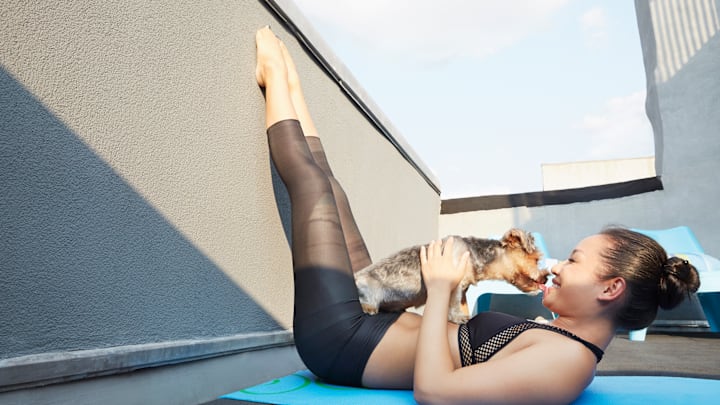Many of us are accustomed to spending hours sitting at a desk while working, which isn’t beneficial when it comes to health. The Mayo Clinic reports that extended sitting has been linked to conditions like obesity, high cholesterol, high blood pressure, and other cardiovascular issues. Simply standing up every 30 minutes can boost your overall wellbeing, but there’s one yoga pose that can also help you out.
- Stuck at a Desk? Try This Yoga Pose
- How to Do the Legs-Up-The-Wall Pose
- Who Should Avoid Legs-Up-The-Wall
Stuck at a Desk? Try This Yoga Pose
The pose in question is called viparita karani, a.k.a “legs-up-the-wall” pose. As the name suggests, you put your bottom and legs against the wall as you lie flat on the ground. This position is known as an inverted pose because “the upper body is inverted from its normal, upright position,” according to Dr. Robert Saper, chair of wellness and preventive medicine at the Cleveland Clinic.

One of the potential benefits of the legs-up-the-wall pose is that it can improve blood circulation, particularly for individuals who have been sitting or standing for extended periods. Being in either position for too long can cause blood to pool in the legs; the yoga pose recirculates the fluid back into other parts of the body.
Unlike other inverted positions, such as the downward dog, headstand, and handstand, legs-up-the-wall doesn't require balance and doesn’t strain the neck or head.
How to Do the Legs-Up-The-Wall Pose
Almost anyone can do the pose by following these steps:
- Start by laying down a blanket or mat on the floor against the wall. It’s okay to use a pillow if you find it necessary.
- Lie on the floor perpendicular to the wall, with your tailbone on the floor, and your bottom a few inches away from the wall. Your legs should also be up in the air and against the wall, as you’re flexing your feet. The key is to feel a slight stretch in your legs.
- While in the position, relax your body and breathe deeply. Dr. Saper recommends about two to three minutes, but it’s OK to do it for a longer period.
- Slowly sit up and wait for at least 30 seconds before standing. If you rise too quickly from an inverted pose, you may get dizzy.
You May Also Like:
- You Really Should Be Wearing Sunscreen While Driving—Here’s Why
- 10 Facts About the Flu Shot
- Why We Can’t Resist Sticking Q-Tips in Our Ears, Even Though It’s Dangerous
Who Should Avoid Legs-Up-The-Wall
Keep in mind that the legs-up-the-wall pose isn’t for everyone. Those who have the following health conditions should avoid doing the pose:
- Glaucoma
- Conditions that cause excessive fluid buildup (such as congestive heart failure, kidney failure, or liver failure)
- High blood pressure that’s not under control
People who are pregnant or have heart problems, respiratory disorders, spinal disorders, or retinal detachment should also consult their doctors before attempting the legs-up-the-wall pose.
